
The Old Grodno Castle (also known as the Grodno Upper Castle and Bathory's Castle) originated in the 11th century as the seat of a dynasty of Black Ruthenian rulers, descended from a younger son of Yaroslav the Wise of Kiev.

The Old Grodno Castle (also known as the Grodno Upper Castle and Bathory's Castle) originated in the 11th century as the seat of a dynasty of Black Ruthenian rulers, descended from a younger son of Yaroslav the Wise of Kiev.
The first wooden castle was built in the 11th century at the confluence of the Neman and the Gorodnichanka rivers. [1]
The 13th-century keep of the castle belonged to a type of Belarusian defensive tower represented by the Tower of Kamyanyets. Vytautas the Great rebuilt the castle in stone and added five Brick Gothic towers in 1391–98, transforming it into one of his main residences. Casimir IV Jagiellon also favoured Grodno over Lithuania's official capital. It was there that the Polish Crown was offered to him, and it was there that he died in 1492. [2]
The next notable tenant of the castle was Stephen Báthory who envisaged Grodno as the capital of his vast empire in Eastern Europe. He engaged Scotto of Parma to replace the Vytautas Castle with his own residence in the advanced Renaissance taste of Northern Italy. After Bathory's death in Grodno in 1586, his pet project was abandoned. The citadel was devastated by the Russians during a Russo-Polish War in 1655. [3]
The castle's revival took place in 1673-78 due to Krzysztof Zygmunt Pac who raised sufficient funds to finance the refurbishing of the royal residence. The restored castle was selected by King Michał Korybut Wiśniowiecki of Poland as the location for every third Sejm of the Polish–Lithuanian Commonwealth. The castle suffered extensive damage during the Great Northern War, forcing the royal court to move into the New Grodno Castle. [4]
After the partitions of Poland the castle was given over to the Russian army and housed a barracks. The authorities of interwar Poland restored the chamber of the ambassadors and the Sejm Hall.
At present the castle serves as a historical and archaeological museum with a collection of more than 200,000 artifacts, one of the largest in Belarus. [5]
The newest reconstruction began in 2017. [6]
The restoration of the Old Grodno Castle was criticized due to the lacking of historical authenticity. [7] [8] For instance, the contemporary viewpoint was added near the central gates. [9] Some specialists disputed the restoration project, they found significant mistakes in documentation that appeared because the constructor couldn’t read historical inventory descriptions written in Polish and German. For example, the shape of the dome above the central tower, added levels between towers and galleries. Some authentic 16th century walls were demolished. [10] [11]

Grodno or Hrodna is a city in western Belarus. It is one of the oldest cities of Belarus. The city is located on the Neman River, 300 kilometres (190 mi) from Minsk, about 15 kilometres (9.3 mi) from the border with Poland, and 30 kilometres (19 mi) from the border with Lithuania. As of 2023, the city has a population of 358,717 inhabitants. Grodno serves as the administrative center of Grodno Region and Grodno District, though it is administratively separated from the district.

Trakai is a city and lake resort in Lithuania. It lies 28 kilometres west of Vilnius, the capital of Lithuania or just 7 kilometres from the administrative limits of the Lithuanian capital city. Because of its proximity to Vilnius, Trakai is a popular tourist destination. Trakai is the administrative centre of Trakai district municipality. The city is inhabited by 5,357 people, according to 2007 estimates. A notable feature of Trakai is that the city was built and preserved by people of different nationalities. Historically, communities of Karaims, Tatars, Lithuanians, Russians, Jews and Poles lived here.
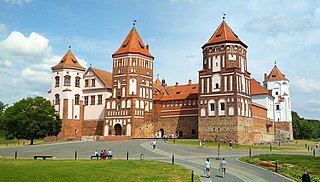
Grodno Region or Hrodna Region, also known as Grodno Oblast or Hrodna Voblasts, is one of the regions of Belarus. It is located in the western part of the country. Its administrative center, Grodno, is also the largest city in the region.

The Mir Castle Complex is a historic fortified castle and a UNESCO World Heritage Site in Belarus. It is located in the town of Mir, in Karelichy District of Grodno Oblast, 29 kilometres (18 mi) north-west of another World Heritage site, Nesvizh Castle. Mir Castle Complex is 164 metres (538 ft) above sea level. Erected in the 16th century in the late Brick Gothic style, it is one of the few remaining architectural monuments of the former Polish–Lithuanian Commonwealth in contemporary Belarus.

The coat of arms of Lithuania is a mounted armoured knight holding a sword and shield, known as Vytis. Since the early 15th century, it has been Lithuania's official coat of arms and is one of the oldest European coats of arms. It is also known by other names in various languages, such as Waykimas, Pagaunė in the Lithuanian language or as Pogonia, Pogoń, Пагоня in the Polish, and Belarusian languages. Vytis is translatable as Chase, Pursuer, Knight or Horseman, similar to the Slavic vityaz. Historically – raitas senovės karžygys or in heraldry – raitas valdovas.

The Wilno Voivodeship was one of 16 Voivodeships in the Second Polish Republic, with the capital in Wilno. The jurisdiction was created in 1926 and populated predominantly by Poles, with notable minorities of Belarusians, Jews and Lithuanians. Before 1926, the voivodeship's area was known as the Wilno Land; it had the same boundaries and was also within the contemporary borders of Poland at the time.
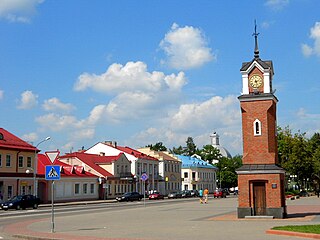
Shchuchyn is a town in Grodno Region, Belarus. It serves as the administrative center of Shchuchyn District. As of 2023, it has a population of 15,653.

Belarus and Lithuania established diplomatic relations on 24 October 1991, shortly after the dissolution of the Soviet Union. The two countries share 680 kilometres (420 mi) of common border. Lithuania's border with Belarus is the country's longest border. For Belarus it is its 3rd-longest border.

The Church of St. Michael is an Eastern Orthodox church on the northern outskirts of the village of Synkavichy, Zelva District, Hrodna Province, in Belarus. It is an example of the Belarusian Gothic and one of the first fortified churches in the Grand Duchy of Lithuania along with the Church of the Nativity of the Blessed Virgin Mary in Muravanka.
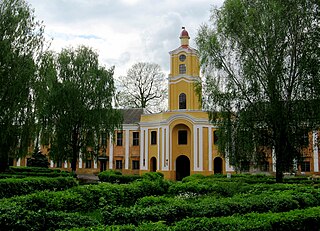
Olyka Castle is a fortified palace in Olyka, Ukraine. Constructed in 1564, it became the principal seat of the Radziwiłł family in Volhynia, once part of the Polish–Lithuanian Commonwealth and now Ukraine. The Radziwiłłs hold the castle for almost four hundred years, since the last owner, Janusz Radziwiłł, owned the castle till 1945. After 1945, it was confiscated and changed into a psychiatric hospital. In 2021, it was transferred to the Volyn museum and is now open for the public.

Lida Castle is a historic, medieval castle in Lida, Grodno Region, western Belarus.

The New Castle in Grodno, Belarus is a royal palace of Augustus III of Poland and Stanisław August Poniatowski where the famous Grodno Sejm took place in 1793. New Grodno Castle is 116 metres (381 ft) above sea level.
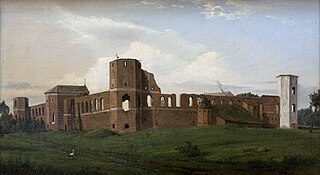
Halshany or Holszany Castle is the ruined residence of the Sapieha magnate family in Halshany, Hrodna Voblast, Belarus. It used to be the seat of one of the largest land estates in the Grand Duchy of Lithuania.

Church of the Blessed Virgin Mary was a Roman Catholic parish church in the city of Grodno. It was founded by Vytautas, Grand Duke of Lithuania before 1389 during the Christianization of Lithuania. Because of its founder, it was commonly referred to as Vytautas' Church. Rebuilt as a Gothic church around 1494, it was one of Grodno's principal Catholic churches until the post-World War II Soviet occupation. It was used by the Russian Orthodox Church since 1804 for roughly a century after the Catholic church was confiscated by the Russian Tsar. It was given back to the Roman Catholic Church during the interwar and World War II, except during the Soviet occupation of 1940–1941. Neglected in the aftermath of World War II, it was finally demolished in 1961.
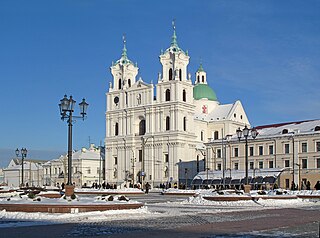
St. Francis Xavier Cathedral is a Roman Catholic cathedral in Grodno, Belarus. Originally a Jesuit church, it became a cathedral in 1991, when the new diocese of Grodno was erected. Nowadays it is one of only three minor basilicas in Belarus.

In the history of Poland, a royal city or royal town was an urban settlement within the crown lands.

The Jesuit Pharmacy in Grodno is a pharmacy built in the market square in Grodno, then in the Polish–Lithuanian Commonwealth, between 1700 and 1709. It is the oldest pharmacy in present-day Belarus.

Grodno Azot is an open joint-stock company, Belarusian state-run producer of nitrogen compounds and fertilizers located in Grodno, Belarus.

The architecture of Belarus spans a variety of historical periods and styles and reflects the complex history, geography, religion and identity of the country. Several buildings in Belarus have been designated as UNESCO World Heritage Sites in recognition of their cultural heritage, and others have been placed on the tentative list.

Church of the Holy Trinity is a Roman Catholic church in Gierviaty, Grodno Region, in Belarus. It is an example of the Belarusian Neogothic architecture and was built in 1899–1903. The church is a site of cultural heritage of Belarus.